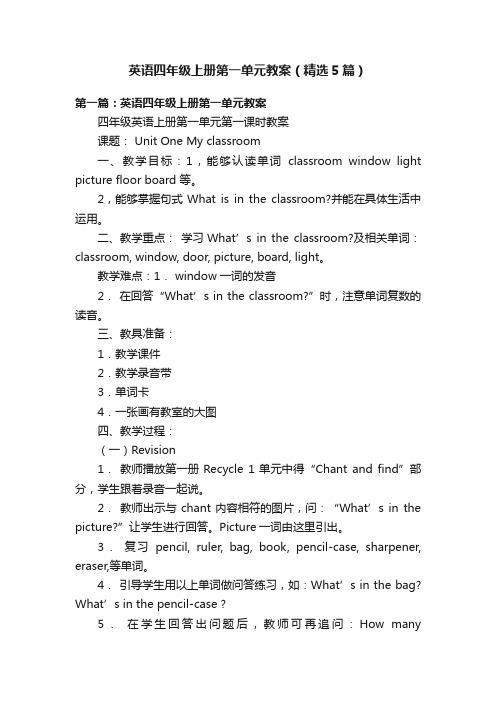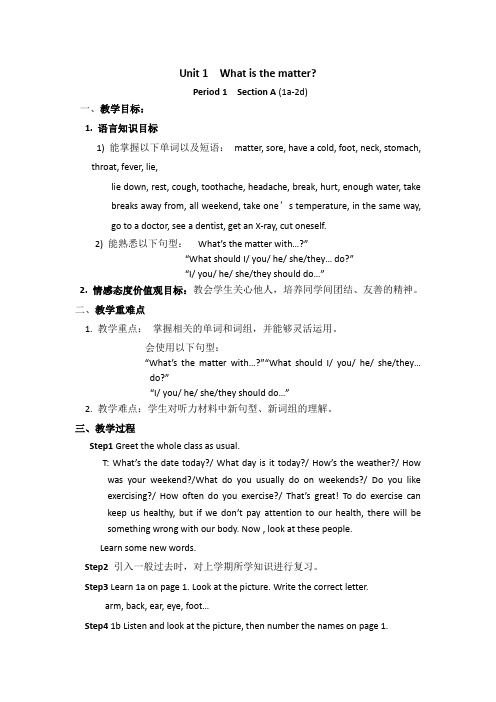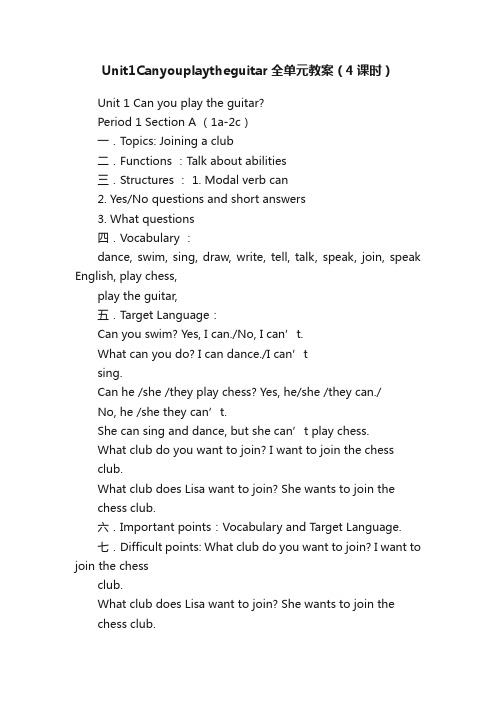Unit1 整单元教案
四年级英语上册第一单元教案【优秀8篇】

四年级英语上册第一单元教案【优秀8篇】(经典版)编制人:__________________审核人:__________________审批人:__________________编制单位:__________________编制时间:____年____月____日序言下载提示:该文档是本店铺精心编制而成的,希望大家下载后,能够帮助大家解决实际问题。
文档下载后可定制修改,请根据实际需要进行调整和使用,谢谢!并且,本店铺为大家提供各种类型的经典范文,如合同协议、条据文书、策划方案、总结报告、党团资料、读书笔记、读后感、作文大全、教案资料、其他范文等等,想了解不同范文格式和写法,敬请关注!Download tips: This document is carefully compiled by this editor. I hope that after you download it, it can help you solve practical problems. The document can be customized and modified after downloading, please adjust and use it according to actual needs, thank you!Moreover, our store provides various types of classic sample essays, such as contract agreements, documentary evidence, planning plans, summary reports, party and youth organization materials, reading notes, post reading reflections, essay encyclopedias, lesson plan materials, other sample essays, etc. If you want to learn about different formats and writing methods of sample essays, please stay tuned!四年级英语上册第一单元教案【优秀8篇】作为一名人·民教师,常常要根据教学需要编写教案,借助教案可以更好地组织教学活动。
人教版英语八年级上册 Unit 1 全单元教案

Step5Listening
Tell Ss they will hear a conversation about three students’conversations. Listen for the first time and fill in the chart. Then listenagainandcheck Yes, or No.Let Ss readthe phrases in the chart of 2b.Play the recording. Do2aand 2b.
③—Did you go with anyone?—Yes, I did./No, I didn’t.
Language points
anyone, anywhere, wonderful, quite a few, most,something, nothing, everyone, of course, myself, yourself
Key points
①一般过去时态的特殊疑问句,一般疑问句及其肯定、否定回答。
②用所学的功能语言交流假期去了什么旅行。
Difficult points
①—Where did you go on vacation?—I went to the mountains.
②—Where did Tina to on vacation?—She went to the beach.
2)阅读填空能力的提高。
Language points
人教PEP三年级上册英语Unit1 整单元教案

人教PEP三年级上册英语教案Unit 1 Hello!Teaching aims:1.listen, speak” Hello./hi. Goodbye./bye-bye. I'm ....”2.pass the creaton greetings, introduce yourself and say goodbye, etc scenarios, let the students learn greetings, introduce yourself and farewell colloquialisms 3.cultivate students willing to openings, dare to speak English habits, inspiring students want to learn, and loving wishes.Teaching key point: Greetings, introduce yourself and say farewell greetings session learning, so that students in differen t situations to listen, speak “Hello./hi. Goodbye./bye-bye. I'm ....”Teaching difficult:pronunciation of “I’m”Teaching aid:mask,tape第一课时Teaching content:Part A Let’s talk,Let’s playProcess of teaching :一、Warm-up1.Teacher show the picture about “Cartoon”,students look at the picture and listen dialoge.2.Tell students “cartoon” pronunciation is made by the word of English words cartoon directly translation of pronunciation.In reality, we still have many similarities, sometimes we even directly used English words to represent something as a CD, VCD, DVD, etc二、Presentation1.Broadcast song “Hello”.2.Teacher extend greetings to students:”Hello, everyone.”3.Teacher introduce self :”Hello!I’m Miss yang/Hi!I’m Miss yang.”4.Teacher show the mask and introdu ce:”Hello!I’m sary.”5.Students introduce with mask:”Hello!I’mMike……6.Broadcast the tape and students listen “Let’s talk”.三、Practice1.Let’s playStudents play game “One is drumming while the others pass round a spray of blossom -- a drinking-game (whoever has the blossom when the drum stops must drink a cup of wine).2.Produce the picture ,Let students say what to say in the picture.1)Morning,two children meet at the school doorway,what they say?2)Class begin,teacher brings a new schoolmate into classroom,freshmanintroduce self.3)Get out of class,there are several classmate and freshman meet ,how theysay?4)School is over,classmate say what each other.3.Four a group practice to introduce self.四、AssessmentTeacher and students do students’exercise-book Unit 1 Part 1.五、Add-activitiesMake the mask about somebody in book.Feedback:第二课时Teaching content:Part A Let’s learn, Let’s doProcess of teaching:一、Warm-up1.Sing a song:”Hello”2.Students take Sarah, Wu Yifan counterpart masks and introduce:”Hello!sarah!......”3.Play a game:Listen sounds,find pals.二、Presentation1.Teach words and use sentences:”Show me your…….”Teacger show a bag and students guess :”What’s in the bag?”Students guess and teaacher present the things,teacher teach word.Teacher says order:”Show me your …….”2.teacher read and students follow teacher。
七年级上册英语Unit 1 单元教案

七年级上册英语Unit 1单元教案一、单元教材分析本单元围绕“结交新朋友”使学生学会打招呼和介绍自己、询问他人姓名的基本句型:“What’s your/his/her name?My/His/Her name is…”; 通过学习区分"First/last name”,了解有关姓名的文化知识;通过查询电话号码“What’s your/her/his phone number?”,学习数字1~9,同时也进一步促进学生之间的相互了解;通过以上几个方面的学习,使学生在轻松、愉快的学习氛围中熟识新伙伴。
本单元与第二单元衔接紧密:由课堂内的打招呼、自我介绍到课外、校外相互了解。
由特殊疑问句的学习到一般疑问句的学习,使学生将书本知识运用到实际生活中。
二、单元学情分析本单元的主题是熟识新伙伴,同时引导学生采用Practicing, Listening for specific information和Role playing的学习策略,学习一些新词汇,掌握一些重点句型,在小组合作学习的过程中,进一步促进学生之间的相互了解。
三、单元教学建议本单元可综合运用讲授式、启发式、自主学习、合作学习等各种策略,提供大量的学习资源,通过老师向学生进行的自我介绍,同学自我介绍传句子比赛,自我查资料表演,自制明信片等的活动,使学生能够学到知识,又增加了他们的学习的乐趣。
来培养学生的自主学习的能力及表达能力和逻辑思维能力。
采用Practicing, Listening for specific information和Role playing的学习策略,利用教学图片或制作多媒体课件来展开课堂Pair work, Group work的口语交际活动,询问他人姓名、查询电话号码,了解有关姓名的文化知识。
Section A 1 (1a-2d)一、教学目标:1.能掌握以下单词:name nice meet his and her your能掌握以下句型:①—Hi. My name’s Gina.—I’m Jenny. Nice to meet you!②—What’s your/his/her name?—My/His/H er name is…③—Are you…?—Yes, I am. / No, I'm not.④—Is he/she…?—Yes, she/he is. / No, she/he isn’t.2. 能了解以下语法:your, his, her等形容词性物主代词的简单用法;What’s=what is I’m=I am name’s=name is等缩写形式。
英语四年级上册第一单元教案(精选5篇)

英语四年级上册第一单元教案(精选5篇)第一篇:英语四年级上册第一单元教案四年级英语上册第一单元第一课时教案课题: Unit One My classroom一、教学目标:1,能够认读单词classroom window light picture floor board 等。
2,能够掌握句式What is in the classroom?并能在具体生活中运用。
二、教学重点:学习What’s in the classroom?及相关单词:classroom, window, door, picture, board, light。
教学难点:1. window一词的发音2.在回答“What’s in the classroom?”时,注意单词复数的读音。
三、教具准备:1.教学课件2.教学录音带3.单词卡4.一张画有教室的大图四、教学过程:(一)Revision1.教师播放第一册Recycle 1单元中得“Chant and find”部分,学生跟着录音一起说。
2.教师出示与chant内容相符的图片,问:“What’s in the picture?”让学生进行回答。
Picture一词由这里引出。
3.复习pencil, ruler, bag, book, pencil-case, sharpener, eraser,等单词。
4.引导学生用以上单词做问答练习,如:What’s in the bag? What’s in the pencil-case ?5.在学生回答出问题后,教师可再追问:How manypencils/pens…?使学生能用复数进行回答。
如:What’s in the pencil-case? A ruler, two pencils…(二)Presentation1.教师把一张画有教室的大图贴到黑板上,说:This is a classroom.What’s in the classroom?2.学生听懂后,教师可先试着让学生回答,能说出英文的学生给与表扬也可让学生用中文回答。
Unit 1 What's the matter?全单元教案

Unit 1 What is the matter?Period 1 Section A (1a-2d)一、教学目标:1. 语言知识目标1) 能掌握以下单词以及短语:matter, sore, have a cold, foot, neck, stomach,throat, fever, lie,lie down, rest, cough, toothache, headache, break, hurt, enough water, takebreaks away from, all weekend, take one’s temperature, in the same way,go to a doctor, see a dentist, get an X-ray, cut oneself.2) 能熟悉以下句型:What’s the matter with…?”“What should I/ you/ he/ she/they… do?”“I/ you/ he/ she/they should do…”2. 情感态度价值观目标:教会学生关心他人,培养同学间团结、友善的精神。
二、教学重难点1. 教学重点:掌握相关的单词和词组,并能够灵活运用。
会使用以下句型:“What’s the matter with…?”“What should I/ you/ he/ she/they…do?”“I/ you/ he/ she/they should do…”2. 教学难点:学生对听力材料中新句型、新词组的理解。
三、教学过程Step1 Greet the whole class as usual.T: What’s the date today?/ What day is it today?/ How’s the weather?/ How was your weekend?/What do you usually do on weekends?/ Do you like exercising?/ How often do you exercise?/ That’s great! To do exercise can keep us healthy, but if we don’t pay attention to our health, there will be something wrong with our body. Now , look at these people.Learn some new words.Step2 引入一般过去时,对上学期所学知识进行复习。
部编版五年级英语上册第一单元新要求整单元设计教案

部编版五年级英语上册第一单元新要求整单元设计教案教学目标1. 学生能够掌握本单元的词汇和句型。
2. 学生能够运用所学知识进行简单的对话和问答。
3. 学生能够理解并正确运用一些基本的英语语法规则。
教学准备1. 教师准备教材《部编版五年级英语上册》第一单元的教学内容。
2. 教师准备相关的教具和教学素材,如单词卡片、图片、录音等。
教学步骤1. 导入新课(5分钟)- 教师用图片或实物引入新课,激发学生对主题的兴趣。
- 教师播放录音,让学生听一段对话,帮助他们熟悉新单词和句型。
2. 单词和句型研究(15分钟)- 教师通过图片、单词卡片等方式教授本单元的单词和句型。
- 教师带领学生进行词汇和句型的操练,确保学生能够正确地发音和运用。
3. 对话练(20分钟)- 教师分组让学生进行对话练,互相问答和回答问题。
- 教师鼓励学生运用所学内容进行创造性对话,增强口语表达能力。
4. 游戏活动(15分钟)- 教师设计一些有趣的游戏活动,如单词接龙、猜谜语等,巩固学生的词汇和句型。
5. 课堂总结(5分钟)- 教师对本节课的重点内容进行总结,强调学生在研究中的进步和需要继续努力的方面。
教学延伸1. 学生可通过自主阅读英语故事书、听英语歌曲等方式拓展英语研究。
2. 学生可利用研究软件或网站进行英语听力和口语练。
3. 学生可互相组织小组活动,进行角色扮演和对话练。
教学评价1. 教师通过观察学生上课表现、听说读写能力等方面进行评价。
2. 教师可设计一些小测验或练,用以检验学生对本单元内容的掌握程度。
3. 教师可对学生的口头表达和书面作业进行评价,提供及时的反馈和指导。
教学反思1. 教师应关注学生的研究兴趣和研究动机,根据实际情况调整教学内容和方式。
2. 教师应注重培养学生的研究策略和自主研究能力,引导他们主动参与英语研究。
3. 教师应及时反思教学过程和效果,不断提升自身的教学能力和教学质量。
以上是《部编版五年级英语上册第一单元新要求整单元设计教案》的简要内容。
Unit1Canyouplaytheguitar全单元教案(4课时)

Unit1Canyouplaytheguitar全单元教案(4课时)Unit 1 Can you play the guitar?Period 1 Section A (1a-2c)一.Topics: Joining a club二.Functions :Talk about abilities三.Structures : 1. Modal verb can2. Yes/No questions and short answers3. What questions四.Vocabulary :dance, swim, sing, draw, write, tell, talk, speak, join, speak English, play chess,play the guitar,五.Target Language:Can you swim? Yes, I can./No, I can’t.What can you do? I can da nce./I can’tsing.Can he /she /they play chess? Yes, he/she /they can./No, he /she they can’t.She can sing and dance, but she can’t play chess.What club do you want to join? I want to join the chessclub.What club does Lisa want to join? She wants to join thechess club.六.Important points:Vocabulary and Target Language.七.Difficult points: What club do you want to join? I want to join the chessclub.What club does Lisa want to join? She wants to join thechess club.教学过程修订、增减Step 1 Revision and lead in.T: I like basketball. Do you like basketball? Does he/she like basketball?T:I like music. Do you like music? Does he/she like music?Step 2 Presentation.1. Show the guitar, and ask What’s this? (It’s a guitar.) Read the new word, then ask:Can you play the guitar? Help the students answer: Yes, I can. / No, Ican’t.2. T;We’ll learn unit 1 Can you play the guitar? Section A. Read thetitle.3. Show the pictures and learn the new words, and stand up and say“sing,sing, I can sing.”“sing, sing, I can’t sing.”Learn the other words likethis.4. Let’s chant.(1).Dance, dance, I can dance very well. Sing, sing, He can sing very well.Swim, swim, she can swim very well. Chess,chess, we can play chessvery well.Soccer, soccer, can you play soccer?(2). Who is the best? (say and do the actions).Change the verb(动词)or phrases(短语) ,like draw, play the guitar, speak English.5. Read the chant again, 聪明的你能发现can在肯定句中的运用规律吗?6. Show the clubs, and learn to read the words 。
- 1、下载文档前请自行甄别文档内容的完整性,平台不提供额外的编辑、内容补充、找答案等附加服务。
- 2、"仅部分预览"的文档,不可在线预览部分如存在完整性等问题,可反馈申请退款(可完整预览的文档不适用该条件!)。
- 3、如文档侵犯您的权益,请联系客服反馈,我们会尽快为您处理(人工客服工作时间:9:00-18:30)。
课前反思:
课后反思:
Blackboard Design
“问题导学、互动探究”教案
Title:Unit1 How can we becomegood learners?Section A3a-3b
Grade:NineDate: Period:2Teacher:
2cRole-play the conversation.
Language points
1. I study by working with a group.By+ V-ing表通过做某事
2辨析aloud, loud和loudly
aloud出声地;大声地。常与read/ call等词连用,不用于比较级。
T:How doyou study English?
S: I study English by ______. by working with friends.\by making word cards.\by asking the teacher for help.\by reading the textbook.\by working with a group.\by listening tapes.
Can you guess how she studies English ?
Step3Finish3a:Read the passage about Wei Fen and answer the questions.
1)Why did Wei Fen find it difficult to learn English?
2.能力目标:3.情感态度价值观目标:
Important Points
1.学会运用how来询问做事方式
2.学会运用by+doing的结构表达做事方式。by介词,表示“通过……方法或途径”,译成“靠、通过”。by后面可以加名词或动名词短语。
3.动名词的构成:动词后加动名词doing,相当于名词,在句子中可以做主语、宾语、表语定语等。
too ... to ...结构常表示“太……而不能……”, too后面接形容词或副词, to后面接动词原形。
Complete the following sentences.
1.大声朗读来练习发音怎么样?
What about ____________ to practice pronunciation?
Step1Listening
1bListen. How do these students study for a test? Write letters from1aabove.
2aListen and check the questions you hear.
2b Listen again. Match each answer below with a question above.
3.a piece of cake表示事情非常简单、易于解决,相当于汉语的“小菜一碟;小事一桩”; serves sb.right则相当于汉语说某人“活该”。
4.【look用法归纳】
look up (在词典、参考书中或通过电脑)查阅;抬头看look after照顾look like看起来像look out当心,小心look through浏览look for寻找look forward to期待look around向四周看have/take a look看一看look ove检查
2. Find out your learning methods.
3. The words and expressions in this unit.
2.能力目标:
3.情感态度价值观目标:
Important Points
1.学会运用how来询问做事方式
2.学会运用by+doing的结构表达做事方式。by介词,表示“通过……方法或途径”,译成“靠、通过”。by后面可以加名词或动名词短语。
3.我爸爸经常开车去上班。
Step 8 Summary
How do you study English?
1. by working with friends2. by watching English movies. 3. by making word cards.4. by reading the textbook.5. by listening to tapes.6. by asking the teacher for help. 7. by reading aloud.
2.她通过读课本来学习英语。
She studies English __________ the textbook.
3. She improves her English _______________ (通过加入英语俱乐部).
Translation.
1.老师要求我大声朗读课文。
2.不要这么大声。婴儿在睡觉。
How do you study English?
I study by ______________.
Step2Look at the picture on page 3, then let the students talk about:
The girl is Wei Fen. What is she doing?
3.动名词的构成:动词后加动名词doing,相当于名词,在句子中可以做主语、宾语、表语定语等。
Difficult Points
动名词的构成:动词后加动名词doing,相当于名词,在句子中可以做主语、宾语、表语定语等。
Teaching Methods
Pair work; cooperation
Teaching Tools
1.学会运用how来询问做事方式
2.学会运用by+doing的结构表达做事方式。by介词,表示“通过……方法或途径”,译成“靠、通过”。by后面可以加名词或动名词短语。
3.动名词的构成:动词后加动名词doing,相当于名词,在句子中可以做主语、宾语、表语定语等。
Difficult Points
动名词的构成:动词后加动名词doing,相当于名词,在句子中可以做主语、宾语、表语定语等。
2)What did she do in English class?
3)What is the secret to language learning?
Step4Finish 3b:Complete the sentences with what Wei Fen learned from watching movies. Use words and phrases from the passage.
Language points
1.【find用法归纳】
find sb. doing sth.发现某人做某事
find it +adj. + to do sth.发现做某事很……
find it +adj. to do sth.中的it是形式宾语,adj.做宾补, to do sth.是真正的宾语。同类的动词还有think, feel, consider等。
Tape recorder; PPT.
Teaching Process
Notes
Warming up
T: How do you study English? Do you study English by the following ways? (Show some pictures and present theimportant phrases.)
Difficult Points
动名词的构成:动词后加动名词doing,相当于名词,在句子中可以做主语、宾语、表语定语等。
Teaching Methods
Pair work; cooperation
Teaching Tools
Tape recorder; PPT.
Teaching Process
Notes
2.【afraid用法归纳】
be afraid of sth./doing sth.害怕做某事(担心出现某种不良后果)
be afraid to do sth.害怕去做某事(“怕”或“不敢”去做某事)
be afraid +that恐怕……(礼貌地说出令人不快、失望或感到遗憾的事)
call on sb.拜访某人
语言学习的秘密look up the word in the dictionary
。
Reflection After Teaching
课前反思:
课后反思:
Blackboard Design
“问题导学、互动探究”教案
Title:Unit1 How can we becomegood learners?Section A Grammar work; cooperation
Teaching Tools
Tape recorder; PPT.
Teaching Process
Notes
Step1Give the students somepictures, then let them talk about:
Step5Summary
发现做某事很难find it difficult to do sth.语言学习的秘密the secret to language learning
害怕做某事be afraid to do sth.爱上fall in love with肢体语言body language
脸上的表情the expressions on the faces关健词key words对……感兴趣be interested in
Grade:NineDate: Period:3Teacher:
